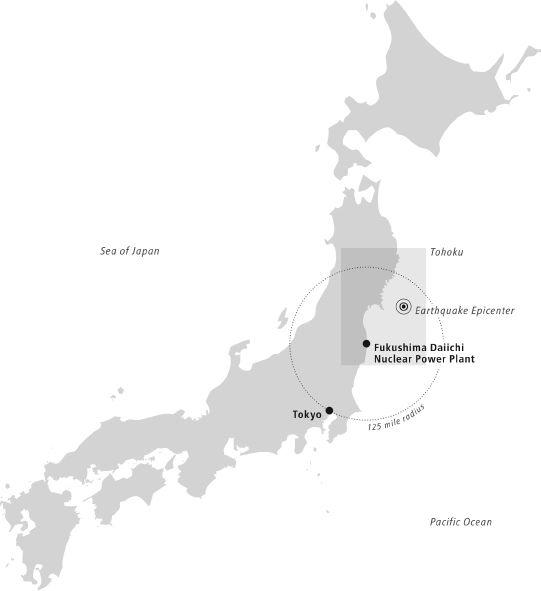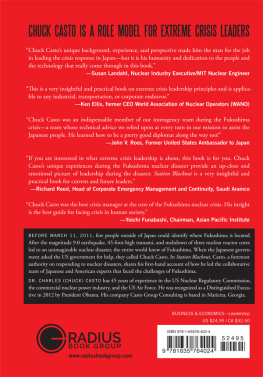STRONG
IN THE RAIN
STRONG
IN THE RAIN
Surviving Japans Earthquake, Tsunami, and Fukushima Nuclear Disaster
LUCY BIRMINGHAM DAVID MCNEILL


STRONG IN THE RAIN
Copyright Lucy Birmingham and David McNeill, 2012.
All rights reserved.
First published in 2012 by PALGRAVE MACMILLAN in the United Statesa division of St. Martins Press LLC, 175 Fifth Avenue, New York, NY 10010.
Where this book is distributed in the UK, Europe and the rest of the world, this is by Palgrave Macmillan, a division of Macmillan Publishers Limited, registered in England, company number 785998, of Houndmills, Basingstoke, Hampshire RG21 6XS.
Palgrave Macmillan is the global academic imprint of the above companies and has companies and representatives throughout the world.
Palgrave and Macmillan are registered trademarks in the United States, the United Kingdom, Europe and other countries.
ISBN 978-0-230-34186-9
All maps and charts designed by the Institute for Information Design Japan, which holds all copyright for work on pages viii, 1, 3031, 5051, 68, 168, and 194195.
Library of Congress Cataloging-in-Publication Data
Birmingham, Lucy, 1956
Strong in the rain : surviving Japans earthquake, tsunami, and Fukushima nuclear disaster / Lucy Birmingham and David McNeill.
p. cm.
ISBN-13: 978-0-230-34186-9
ISBN-10: 0-230-34186-1
1. Tohoku Earthquake and Tsunami, Japan, 2011Personal narratives. 2. Fukushima Nuclear Disaster, Japan, 2011Personal narratives. 3. Disaster victimsJapanTohoku RegionBiography. 4. Tohoku Region (Japan) Biography. 5. Tohoku Region (Japan) Social conditions21st century. I. McNeill, David. II. Title.
DS894.385.B57 2012
952.110512092dc23
[B]
2012024711
A catalogue record of the book is available from the British Library.
Design by Letra Libre, Inc.
First edition: October 2012
10 9 8 7 6 5 4 3 2 1
Printed in the United States of America.
Dedicated to the people of Tohoku.
To Nanako.
And to Seiya, Nina, Sachi, and Luka, in the hope they will see a better future.
CONTENTS

Acknowledgments
THE AUTHORS WOULD LIKE TO GRATEFULLY ACKNOWLEDGE the help of the following people:
Mark Selden, Shaun Burnie, Jeff Kingston, Darach McDonald, and Tom Gill, all of who read and commented on draft chapters of the book. Liz Maly, Christian Dimmer, Ian Fairlie, Eric Johnston, and Dr. Bruce Parker, who read or commented on portions of the book. Jake Adelstein, Roland Kelts, and Robert Whiting, who kindly read the first draft.
Roger Pulvers, who supplied endlessly helpful advice and peerless translations of Kenji Miyazawas poems. Thank you so much Roger. Nanako Otani, who did many of the translations for the book and provided useful suggestions. Mamiko Shimizu, Makiko Tazaki Kimura, Koji Shidara, Koichi Ohtsu, Kei Tanaka, Yasuko Takahashi, and Michiyo Kato for their skilled translations, guidance, and generous support.
Kate Thomson and Hironori Katagiri for their insights on Tohoku culture and history. Dennis Normile, who offered invaluable scientific references and opinion. Interviewees Yukari Tachibana and Chieko Yui for their kind patience. Rachel Vogel, who proposed the project and helped get it off the ground. Jason Ashlock at Moveable Type Management, who understood the premise of the book and believed in it enough to make sure it came to life.
At Palgrave Macmillan, our terrific editor Luba Ostashevsky, and Laura Lancaster and Donna Cherry. Hiroshi Sato, who photographed the books six main characters among many others, introduced us to key contacts, and gave up so much of his time driving us around the Tohoku region. Our remarkable interviewees: Katsunobu Sakurai, Kai Watanabe, Yoshio Ichida, Toru Saito, Setsuko Uwabe and David Chumreonlert, who endured the unendurable, and then agreed to relive it all again so we could record their experiences for this book. Rob Gilhooly, who took some of the most remarkable and moving photographs of the disaster, including the one that adorns the cover of this book. Andreas Schneider, the hugely talented and uncompromising designer of the maps and charts that illustrate the book. Julian Ryall, with whom David McNeill shared an unforgettable three days covering the disaster in Tokyo in March 2011.
To Lucy Birminghams disaster coverage team at TIME, including Howard Chua-Eoan, Zoher Abdoolcarim, Emily Rauhala, and the remarkable Krista Mahr and Hannah Beech, whose bravery and skilled news coverage are a constant inspiration. To David McNeills editors and colleagues at The Irish Times,The Independent, and The Chronicle of Higher Education, who provided a forum and testing ground for our work. To our dedicated and hard working colleagues at NHK. David McNeill would like to give a special mention to the brave Daniel Howden from The Independent, the first British reporter into the exclusion zone.
Finally, to our long-suffering families and friends who bore the brunt of the inevitably draining and time-consuming work that went into this project. We couldnt have done it without you.
PROLOGUE
March 11, 2011
Someone had better be prepared for the rage.
Robert Frost, Once by the Pacific
DAVID MCNEILL, SHINAGAWA, TOKYO
Everyone who lives in Tokyo mentally rehearses where they might be if the Big One strikes. When I first arrived as a student in 1993, I found myself walking through the sprawling, crowded low-ceilinged shopping center of Otemachi and Marunouchi, underneath the citys business district, pondering the apocalypse. The word didnt seem inappropriate: Tokyo has a remarkable, perhaps unique history of almost biblical destruction. In 1923, a 7.9 quake and tsunami famously leveled much of Yokohama and Tokyo, crushing, incinerating, or drowning at least 100,000 people; September 1, the anniversary of that tragedy, is now National Disaster Prevention Day, when millions of schoolchildren practice hiding under desks and evacuating classrooms. Quakes have regularly brought Tokyo and other cities to their knees, and even national icon Mt. Fuji looms threateningly 62 miles away from the capital, ready to spew millions of tons of ash down on the worlds largest metropolis.
Ive often been asked: How do people with millennia of horrific collective memories manage to repress them and get on with life? One answer is that they dontat least not completely. The fear of quakes, tsunamis, and volcanoes of course runs very deep among most Japanese. Time and again after March 11, we would hear stories of our interviewees diving for cover, fleeing their houses, or running from the coast the moment the tremors beganinstincts that would save lives. Im thinking now of photographer Kanae Sato, dashing for her car after the quake struck in Ofunato, then driving past neighbors who stayed behindand died as a resultor fisherman Yoshio Ichida in Soma, leaping from his bath as the shaking began and sprinting for the coast to steer his boat out into the open sea. By the time he returned to port, it had been laid waste.
However, thousands of others ignored ancient precepts about survival in the face of the earthquake and tsunami. In Ofunato, a city with a history of devastating tsunamis, local factory worker Akio Komukai told us about speeding away from the coast after the quake struck and meeting children on their way home from school. They were walking toward the sea and I rolled down the window of my car and shouted, Tsunami tendenko! Theres a tsunami coming; you need to run away! The young people looked at the 61-year-old Cassandra and said, Okay, okay. Komukai, who remembers the 1960 tsunami washing away houses, still wonders who among the children survived. They didnt believe me, he said. We forget that the sea is close because we build next to it. Then the tsunami comes and washes away the houses and you can see the sea again. And were reminded.
Next page










